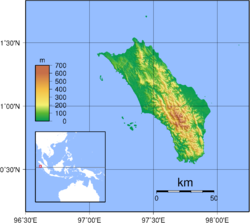I-MAG STS Corporation
On March 28, 2005 at 11:09 PM local time (16:09 UTC) a massive 8.7 earthquake shook
the island of Nias near the northwestern tip of Sumatra for about two minutes. Eight
aftershocks ranging from 5.5 to 6.0 followed in the next twenty-four hours. Hundreds of
buildings on Nias were destroyed and thousands damaged. The total deaths approached
1400 with over 1000 people killed on Nias. Gunungitsoli, the largest town with a
population of 27,000, lost almost one percent of its people. Under the Indian Ocean the
Indo-Australian plate is being forced southwest beneath the Sunda edge of the Eurasian
plate. The same fault line that this subduction is causing hosted the December 26, 2004
event, so when the March earthquake knocked out power to nearby Banda Aceh
thousands of people fled. Fearing a tsunami like the one three months earlier,
evacuations of coastal areas in Thailand, Malaysia and Sri Lanka were started. A three
meter wave caused significant damage to the nearby island of Simeulue (northwest) and
Nias itself was hit by a two meter wave. Sadly, ten people died during the Sri Lankan
evacuation, and nine more were killed when a Sea King helicopter carrying medical
staff from the Australian naval ship HMAS Kanimbla crashed on Nias. Like the coral
reefs that were dying because they had been displaced, two questions stood out. Was
the March event, then our planet's 12th most powerful earthquake, just an aftershock
of the December event? And is increased seismic activity - lots of earthquakes between
4.5 and 6.0 - relieving stress or a prelude to a 8.0 - or higher.
the island of Nias near the northwestern tip of Sumatra for about two minutes. Eight
aftershocks ranging from 5.5 to 6.0 followed in the next twenty-four hours. Hundreds of
buildings on Nias were destroyed and thousands damaged. The total deaths approached
1400 with over 1000 people killed on Nias. Gunungitsoli, the largest town with a
population of 27,000, lost almost one percent of its people. Under the Indian Ocean the
Indo-Australian plate is being forced southwest beneath the Sunda edge of the Eurasian
plate. The same fault line that this subduction is causing hosted the December 26, 2004
event, so when the March earthquake knocked out power to nearby Banda Aceh
thousands of people fled. Fearing a tsunami like the one three months earlier,
evacuations of coastal areas in Thailand, Malaysia and Sri Lanka were started. A three
meter wave caused significant damage to the nearby island of Simeulue (northwest) and
Nias itself was hit by a two meter wave. Sadly, ten people died during the Sri Lankan
evacuation, and nine more were killed when a Sea King helicopter carrying medical
staff from the Australian naval ship HMAS Kanimbla crashed on Nias. Like the coral
reefs that were dying because they had been displaced, two questions stood out. Was
the March event, then our planet's 12th most powerful earthquake, just an aftershock
of the December event? And is increased seismic activity - lots of earthquakes between
4.5 and 6.0 - relieving stress or a prelude to a 8.0 - or higher.

| Return to Projects Click here |